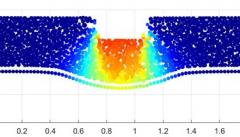
Laboratoire
Soutenance de Nirsine Abou Chaz
Nisrine soutiendra sa thèse la semaine prochaine, en voici le résumé (la soutenance se tiendra en Anglais) :
Poor subgrade quality is a pervasive challenge in the construction of unpaved roads. Geosynthetics (GSYs) have emerged as innovative solutions since their initial usage in the late 1970s. Depending on the type of GSY employed, they can fulfil one or several roles, including separation, reinforcement by tensioned membrane effects, and stabilization by interlocking and/or friction at the soil-GSY interface.
Few design methods exist in the literature to quantify these mechanisms, but they have limitations due to their calibration on specific GSY and soil parameters and, at times, under static rather than cyclic loading conditions. The various factors and parameters that influence the dominant mechanism and its corresponding contribution to platform enhancement underscore the necessity for further exploration in this area.
To address this persistent issue, a series of experimental and numerical studies were conducted. The experimental part studied the performance of reinforcement under cyclic vertical and traffic loadings using two woven geotextiles (GTXs) with two different tensile stiffnesses and two base course thicknesses. Additionally, alongside the experimentation, a numerical model coupling the discrete element method and the finite element method (using Software-Defined Edge Computing) was employed. This model aimed to showcase the impact of GSY and soil parameters on reinforcement performance and provide insights into aspects challenging to measure through experimentation.
The tested unpaved road sections are composed of a subgrade layer with a CBR around 1% covered by a compacted base course layer with thickness of 300 mm or 500 mm. The GTXs are placed at the interface between the subgrade and the base course layers. The results showed that the 500 mm base course reinforced platform did not exhibit reinforcement effects under vertical cyclic loading. However, the use of a 300 mm base course with GTX significantly reduced settlement compared to an unreinforced base course of the same thickness (300 mm) and to the thicker base course (500 mm). The most important improvement was observed with the highest-stiffness GTX. Moreover, three tests were performed under traffic loading applying by the Simulator Accelerator of Traffic (SAT). It was shown that traffic loading exerted greater deformation in the base course layer compared to vertical loading, but definitive conclusion can hardly be reached about the comparison between reinforced and unreinforced platform.
In the numerical model, a behavioural law (1D) was integrated, considering the variation of the subgrade reaction modulus during loading and unloading phases and with cycles, and describing the transition of the soil from plastic to quasi-elastic behavior. In addition, the purely frictional base course layer revealed its incapacity to sustain the loading applied in the experimental. This inherent limitation prompted the incorporation of adhesion between soil particles to rectify this shortcoming in load-bearing capacity. Once calibrated the numerical model proved capable of accurately replicating the behavior of GTX-reinforced platforms in the first cycle and with cycles. It facilitated a quantification of the GTX friction effort and GTX tension effort with cycles. Initially, frictional forces outweighed the tensioned
membrane effect, but as deflection increased with cycles, the latter became more prominent. This dynamic highlighted a diminishing dominance of the soil confinement mechanism with cycles, giving way to the increasing significance of the membrane effect. Furthermore, a parametrical study has been performed to study the influence of the subgrade softness, the GTX rigidity, the mattress-GTX interface parameters and the base course mechanical parameters on the behavior of the model.

